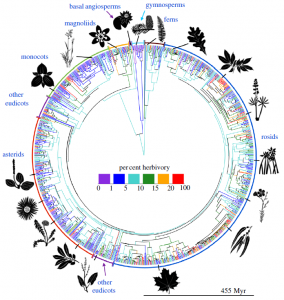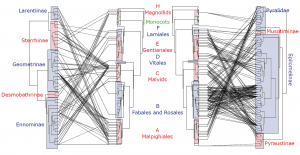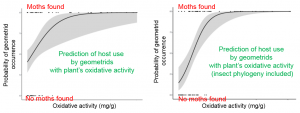When both plant and herbivore species phylogenies are known and the host use patterns revealed, chemistry can be used to both explain the patterns of the foodwebs and to further predict the host use by herbivores
Herbivores know plant chemistry much better than we do

Figure 1. The phylogeny and herbivory rates for the 1058 plant species studied by Turcotte et al. (2014). It can be clearly seen that the herbivory rates differ between the plant lineages, and that there seems to be segments of plant phylogeny where the phylogeny nodes are mostly reddish or blueish. This suggests that it may be possible to find plant lineages with extremely efficient or non-efficient defences, or that there is a big difference in the plant lineages on the level of specialisation among the herbivore species that have co-evolved with the corresponding plant species.
It may be clear that plant species evolution has resulted in different species to have mostly different type of defensive chemistry. Naturally some species may share similar chemistry, but in the big picture we can see species as chemically different. Our views on this are more limited than the views of herbivores, since they may have been acquainted with the species chemistry for several generations, while for us humans the chemistry may be touched never or just very recently, depending on the species in question.
Co-evolution of species has modified both plants and herbivores
It is also clear that we cannot understand at the moment all the details of why certain herbivore species show one host use pattern and others show different one. We just must estimate that these feeding patterns between herbivore and plant species have been modified during long time as both herbivores and plants have co-evolved within hundreds of millions of years. In this respect it may be safe to assume that certain herbivore lineages have evolved to be able to handle certain defense chemistries and may be vulnerable against other types of defenses. All this may have implications to their gut chemistries as well, since that may have evolved so that the detoxification of one but not the other types of compounds is optimized.

Figure 2. Co-phylogeny between geometrid (left) and pyraloid (right) caterpillars and their host use patterns within 122 plant species found in the Papua New Guinea rainforest plots. For details, see Segar et al. (2017).
Herbivory rates may be linked to plant phylogeny – what about chemistry?
In any way, all these evolutionary steps should have resulted in high variation of plant chemistry and also herbivory within the plant phylogeny. Such patterns are not well understood, but exciting examples have been recently published. Turcotte et al. (2014) built the phyogeny of 1058 species and calculated from the literature the herbivore rates witnessed for the species. The overall picture is quite variable as can be seen in Fig. 1, but they did see a pattern between woody and non-woody plants: woody plants experienced 64% higher herbivory than non-woody plants. However, this study did not reveal the links between herbivores, plants and plant chemistry, meaning that we cannot conclude the exact reasons for the observed herbivory differences between the plant species. Obviously we can speculate that it was due to e.g. plant apparency theory, but we at the Natural Chemistry Research Group would like to know, if that pattern is more driven by woody plants being more apparent hosts than non-woody plants, or by the differences obtained in the defensive chemistries between these two major classes of plants. While doing that, we would like know the defense chemistry in detail, since in many cases it is looked only from the perspective of one type of defense compounds such as alkaloids or terpenes.

Figure 3. The oxidative activity of plants measured by the Salminen & Karonen (2011) assay can be used together with the insect phylogeny to accurately predict the presence of geometrid moths on rainforest plants. For details, see Segar et al. (2017).
Plant chemistry can be even used to predict insect host use
Segar et al. (2017) went a step forward and looked at the host use patterns of several herbivore species with multiple plant species. They revealed a host-use network for the species pairs (Fig. 2) and were able to use plants’ oxidative activity as a measure to predict the probability for a plant species to get eaten by a given herbivore species (Fig. 3). Such predictive models could prove to be highly useful especially when the herbivore phylogeny is included in the models. Let’s wait and see what else comes out from this in the future. The aspects are quite exciting and expectations high.
“Of course they eat anything you give them – they even eat each other!”
